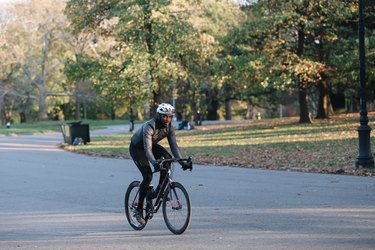
Cycling — either indoors on a stationary bike (like a Peloton) or outdoors taking in the views — is a great low-impact workout that can boost your heart health and build muscle. Because biking doesn't place a ton of stress on your joints, it's also sometimes used as a way to recover from an injury.
A common condition that occurs in active individuals in Achilles tendonitis. It happens when when your Achilles — a large tendon that runs down the back of your lower leg — becomes inflamed, according to the American Academy of Orthopaedic Surgeons (AAOS).
Video of the Day
So, can you bike with Achilles tendonitis? Below, we dig into what the experts have to say about cycling with Achilles pain.
First, What Is Achilles Tendonitis?
The Achilles tendon is a fibrous cord of tissue that connects the muscles in your calves to your heel bone, according to the Mayo Clinic, and is used when you run, walk, jump, climb stairs or stand on your tip toes. When the tendon becomes inflamed from injury or overuse, tendonitis occurs and causes pain and discomfort.
Achilles tendonitis often is sports-related and is associated with overuse of the tendon, as doing too much too quickly can put too much repetitive stress on your Achilles, per the AAOS. Other causes of Achilles tendonitis include:
- Tight calf muscles
- A sudden increase in exercise amount or intensity
- Haglund's deformity (an enlargement of the bone on the back of your heel, which can rub on your Achilles tendon)
If you have chronic pain, stiffness or swelling along your Achilles tendon that worsens with activity, make an appointment with your doctor to confirm a diagnosis of Achilles tendonitis. If you've experienced a sudden pop in the back of your calf or heel, you may have torn your Achilles. Seek immediate medical attention if so.
Can Cycling Cause Achilles Tendonitis?
As we mentioned above, overtraining is one of the culprits of Achilles tendonitis. So, if you've ramped up your cycling miles or intensity recently, you may be at risk for developing the condition.
Additionally, how you ride can potentially cause Achilles tendonitis. An incorrect bike fit, improper pedaling technique and wearing the wrong cycling shoes can lead to the condition, according to the Idaho Sports Medicine Institute.
"If your bike isn't fitted to your body correctly, it can cause your foot to be in an awkward position, which can put unnecessary stress on the Achilles tendon," according to the Idaho Sports Medicine Institute.
Make sure you adjust the height of your bicycle seat to alleviate excessive pull on your tendons. When your leg is extended fully, your Achilles tendon experiences strain that could lead to additional injury and inflammation. A short extension is preferable to reduce the amount of continued stretching your tendons undergo while cycling. If you're not sure if your bike fit is correct, visit your local bike shop for help.
When it comes to pedaling, make sure to pedal in a circular motion as to recruit the right muscles and not put too much stress on your Achilles tendon, per the Idaho Sports Medicine Institute. During the bottom of your pedal stroke, it's helpful to think about scraping a piece of gum off the bottom of your shoe. Your toes should never point down during your pedal stroke either.
And while cycling shoes are dependent on your personal preferences, generally speaking, a shoe with a high heel cup or a very stiff sole may lead to Achilles tendonitis, according to the Idaho Sports Medicine Institute. A high heel cup plus a poor pedal stroke can put a lot of pressure on your Achilles. If you're not sure which cycling shoes are best for you, bike shop pros can help you out.
Can You Bike With Achilles Tendonitis?
Biking with Achilles tendonitis can worsen your pain or even cause your Achilles tendon to eventually tear. If you're experiencing symptoms of Achilles tendonitis, make an appointment with your doctor and stop riding until you get the green light from them to start up again. You can then work with your doctor or physical therapist to come up with a personalized training plan depending on the severity of your tendonitis.
Once you're ready to get back to your regular cycling routine, you should always warm up with proper stretching. One stretch that's particularly helpful is the calf stretch, according to the AAOS, as tight calves can cause Achilles tendonitis.
Calf Stretch
- Face a wall and press your palms into the wall at shoulder-width distance.
- Step your left foot several feet back, keeping your right foot planted.
- Lean into the heel of your back foot as you slightly hinge forward.
- Hold for 5 to 10 seconds, and then switch legs.
You can also do calf-strengthening exercises a few times a week off the bike to minimize your risk of developing Achilles tendonitis again in the future. Here is a helpful move according to the AAOS.
Stair Calf Raise
- Place your toes on the bottom step of a staircase or a sturdy step-stool.
- Position your feet shoulder-width apart with your heels hanging over the edge.
- Lift up onto the tips of your toes and hold for a full second.
- Lower your heels down slowly until your feet are in an upward angle. Hold this position for a full second and repeat.
Tip
To make this exercise harder, you can hold dumbbells or do a calf raise with one leg at a time.